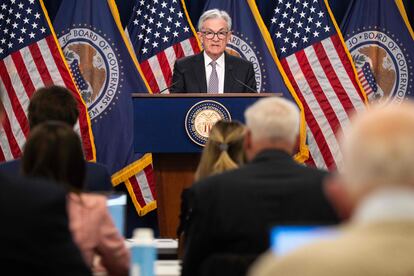Fed keeps rates unchanged but signals likelihood of another hike this year to fight inflation
The move to leave its benchmark rate at about 5.4% suggests that the Fed thinks it has time to wait and see if the 11 rate hikes it unleashed starting in March 2022 will continue to cool rising prices

The Federal Reserve left its key interest rate unchanged Wednesday for the second time in its past three meetings, a sign that it’s moderating its fight against inflation as price pressures have eased. But Fed officials also signaled that they expect to raise rates once more this year. The move to leave its benchmark rate at about 5.4% suggests that the Fed thinks it has time to wait and see if the 11 rate hikes it unleashed starting in March 2022 will continue to cool rising prices.
Consumer inflation has dropped from a year-over-year peak of 9.1% in June 2022 to 3.7% last month. Yet it’s still well above the Fed’s 2% target, and its policymakers made clear Wednesday that they aren’t close to declaring victory over the worst bout of inflation in 40 years.
Besides forecasting another hike by year’s end, their projections showed they envision keeping rates high deep into 2024. They expect to cut interest rates just two times in 2024, down from four rate cuts they had envisioned back in June.
The policymakers’ inclination to keep rates high for an extended period suggests that they remain concerned that inflation might not be falling fast enough toward its 2% target.
The Fed’s rate hikes have significantly raised the costs of consumer and business loans. In fine-tuning its interest rate policies, the central bank is trying to guide the U.S. economy toward a tricky “soft landing” of cooling inflation without triggering a deep recession.
Even as inflation has slowed significantly, the job market and the economy have remained resilient, confounding expectations that the Fed’s series of hikes would cause widespread layoffs and a recession.
The more measured approach to rate increases the Fed is now taking reflects an awareness among the officials that the risks to the economy of raising rates too high is growing. Previously, they had focused more on the risks of not doing enough to slow inflation.
The Fed’s moves underscore that even while the policymakers approach a peak in their series of hikes, they intend to keep rates at or near their high for a prolonged period.
In generating sharply higher interest rates throughout the economy, the Fed has sought to slow borrowing — for houses, cars, home renovations, business investment and the like — to help ease spending, moderate the pace of growth and curb inflation.
Though clear progress on inflation has been achieved, gas prices have lurched higher again, reaching a national average of $3.88 a gallon as of Tuesday. Oil prices have surged more than 12% in just the past month.
And the economy is still expanding at a solid pace as Americans, buoyed by steady job growth and pay raises, have kept spending. Both trends could keep inflation and the Fed’s interest rates high enough and long enough to weaken household and corporate spending and the economy as a whole.
While overall inflation has declined, the costs of some services — from auto insurance and car repairs to veterinary services and hair salons — are still climbing faster than they were before the pandemic. Still, most recent data is pointing in the direction the Fed wants to see: Inflation in June and July, excluding volatile food and energy prices, posted its two lowest monthly readings in nearly two years.
And signs have grown that the job market isn’t as robust as it had been, which helps keep a check on inflation. The pace of hiring has moderated. The number of unfilled openings fell sharply in June and July. And the number of Americans who have started seeking work has jumped. This has brought labor demand and supply into better balance and eased pressure on employers to raise pay to attract and keep workers – a trend that can lead them to raise prices to offset higher labor costs.
In addition, millions of Americans next month will have to resume their student loan payments when a pandemic-era pause ends. That shift toward loan repayments could have the effect of weakening consumer spending, which drives most of the economy.
Still, the path back to lower inflation has become more uneven: On a monthly basis, consumer prices jumped 0.6% in August, the most in more than a year. Compared with a year earlier, prices rose 3.7%, the second straight such increase.
And some factors are threatening to re-ignite inflation, weaken the economy, or both. Rising oil prices, for example, are making gasoline steadily more expensive. Should that trend continue, it would worsen inflation and leave consumers with less money to spend. Even the so-far limited strike by the United Auto Workers union against the Big 3 U.S. automakers could eventually further inflate vehicle prices.
This week’s Fed meeting comes as central banks around the world are mostly raising rates to fight inflation. Prices spiked after the pandemic hampered global supply chains, causing shortages and higher prices. Inflation worsened after Russia’s invasion of Ukraine in February 2022 sent oil and other commodity prices spiking.
The European Central Bank raised its benchmark rate last week for the 10th time to 4%, the highest level on record since the euro was established in 1999, though it signaled that it could be its last hike. The Bank of England is also expected to increase its rate when it meets Thursday. The Bank of Japan, which meets Friday, is under less pressure to boost rates, although it has taken steps to allow Japanese long-term rates to tick up.
Sign up for our weekly newsletter to get more English-language news coverage from EL PAÍS USA Edition
Tu suscripción se está usando en otro dispositivo
¿Quieres añadir otro usuario a tu suscripción?
Si continúas leyendo en este dispositivo, no se podrá leer en el otro.
FlechaTu suscripción se está usando en otro dispositivo y solo puedes acceder a EL PAÍS desde un dispositivo a la vez.
Si quieres compartir tu cuenta, cambia tu suscripción a la modalidad Premium, así podrás añadir otro usuario. Cada uno accederá con su propia cuenta de email, lo que os permitirá personalizar vuestra experiencia en EL PAÍS.
¿Tienes una suscripción de empresa? Accede aquí para contratar más cuentas.
En el caso de no saber quién está usando tu cuenta, te recomendamos cambiar tu contraseña aquí.
Si decides continuar compartiendo tu cuenta, este mensaje se mostrará en tu dispositivo y en el de la otra persona que está usando tu cuenta de forma indefinida, afectando a tu experiencia de lectura. Puedes consultar aquí los términos y condiciones de la suscripción digital.
More information
Archived In
Últimas noticias
Most viewed
- Sinaloa Cartel war is taking its toll on Los Chapitos
- Oona Chaplin: ‘I told James Cameron that I was living in a treehouse and starting a permaculture project with a friend’
- Reinhard Genzel, Nobel laureate in physics: ‘One-minute videos will never give you the truth’
- Why the price of coffee has skyrocketed: from Brazilian plantations to specialty coffee houses
- Silver prices are going crazy: This is what’s fueling the rally










































